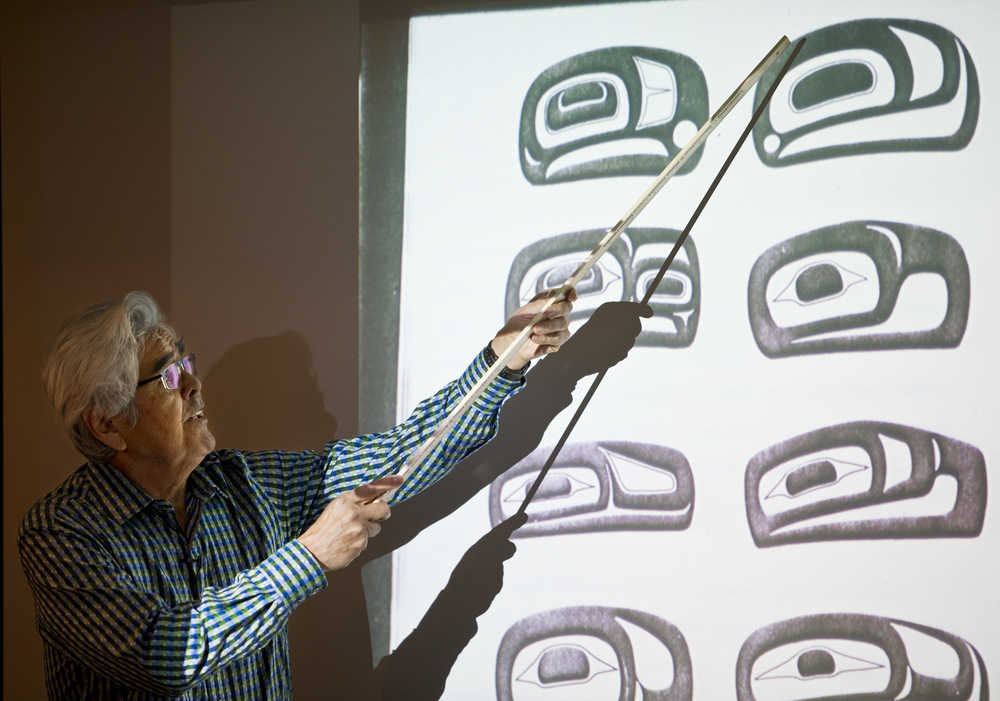When renowned Haida artist Robert Davidson was a kid, he used to root for the cowboys while watching old Westerns, cheering with his friends when the “bad guys” — the Indians — were killed. Then his uncle took him aside and explained that he and his family were “Indians” themselves.
“When he told me, I cried,” Davidson recalled last week during a Native American Heritage Month talk hosted by Sealaska Heritage Institute in Juneau.
The process of discovering his identity as a Haida man went forward from there, quickly picking up speed as he began immersing himself in Northwest Coast art. It’s a trajectory that is still moving forward, one that has placed him among the most celebrated and influential Northwest Coast artists working today.
Davidson’s exploration of Haida art and culture as a young man came at a time when the art had nearly disappeared from his hometown of Masset, British Columbia. Somewhat ironically, he was first introduced to old pieces from his region while visiting museums as a teenager in Vancouver, where art from Haida Gwaii was prominently displayed.
“When I went to the city, people knew more about us than I did,” Davidson, now 69, recalled.
Curious about where the art had gone in Masset, and driven to study as much of it as he could, Davidson said he returned to his village to look for examples.
“I knocked on every door to ask if there was any art left,” Davidson said. “I found one box.”
Though concrete examples were scarce in Masset, Davidson was able to draw on the knowledge and support of his family, many of whom were artists themselves, including his father, Claude Davidson, and his grandfather, Robert Davidson Sr. (whom he referred to in last week’s talk as “tsinii,” the Haida word for grandfather). Davidson’s great grandfather was the celebrated Haida artist Charles Edenshaw.
Davidson himself began learning to carve argillite from his father when he was 13.
“I feel my success (as an artist) came from my grandfather, my uncles, my parents,” Davidson said.
His forward momentum reached its first dramatic peak in August 1969, at the age of 22, when he carved and raised the first totem pole in Masset in nearly 90 years, with the help of his brother Reg and others. The raising of Davidson’s “Bear Mother” pole proved to be a watershed event for Masset, invigorating the town, and spurring elders to remember parts of ceremonial dances and songs. In a previous interview, Davidson compared each person to a thin thread that united to form a strong rope, pulling the knowledge back from the brink of a void into which it might have disappeared forever.
“People had never experienced anything like (the totem raising), myself included,” Davidson said.
Davidson’s grandfather, then in his late 80s, was one of the leaders of the raising. Three weeks later he died peacefully, telling his daughter, “My job is done.”
After the raising, Davidson devoted himself to studying Haida art and culture, learning from experts including Bill Reid and Bill Holm. Now known for his contemporary interpretations of traditional formline, Davidson said creativity within the art form has to happen in the context of traditional knowledge.
“Creating was key in the culture but it had to be with the foundation of knowledge,” Davidson said. “The real key is to learn the foundation from the old masters and to expand on that.”
Davidson said such expansion is also a part of Haida tradition.
“The art was always moving forward,” he said. “There was always a progression.”
One of the important things an artist learns from studying old pieces is a sense of intuition about qualities such as balance and proportion, which are key to understanding Northwest Coast design. We all know what is beautiful, Davidson said, even if we don’t understand why. Study allows creative decision-making to become more automatic.
“Intuitive creativity happens after 10,000 hours of practice,” he said.
Davidson works in many different media, and is known for his carvings, sculpture and paintings. His work has been exhibited at museums including Smithsonian’s National Museum of the American Indian, the National Gallery of Canada in Ottawa, and the Vancouver Art Gallery, and he is widely recognized as one of the most accomplished artists in Canada.
Juneau residents will recognize him as the artist behind one of the most prominent pieces of public art in the city, the huge red metal panels on the Water Soboleff Building. Davidson is one of three artists who created major art pieces for the building, along with Tlingit artist Preston Singletary and Tsimshian artist David Boxley.
Rosita Worl, president of Sealaska Heritage Institute, said Davidson’s widespread influence on the region goes far beyond his physical artwork. Davidson inspired SHI to create its art department years ago, she said, after telling her that traditional art was deteriorating due to a lack of knowledge about formline.
“It was from that teaching, from those words, that we began our art department,” Worl said after Davidson’s presentation. “He was the impetus for us to really concentrate on our art.”
SHI’s art department now includes outreach to villages around the region, as well as to schools and Lemon Creek Correctional Center.
Worl said in a previous Empire interview that Northwest Coast art can be understood as a “very overt manifestation of our culture.”
Davidson’s talk, “Discovering Haida Art: A Personal Journey with Haida Master Artist Robert Davidson” was part of SHI’s Native American Heritage Month series, which continues next week with “Northwest Coast Art Into the Future,” featuring young artists Alison Bremner, David R. Boxley, Rico Worl and Nick Galanin. The presentation will be at noon Thursday, Dec. 3, at the Walter Soboleff Building on the second floor. It is free and open to the public.
For more, visit www.sealaskaheritage.org.

